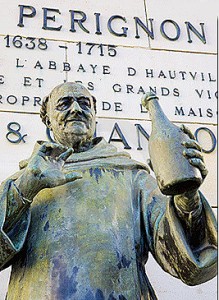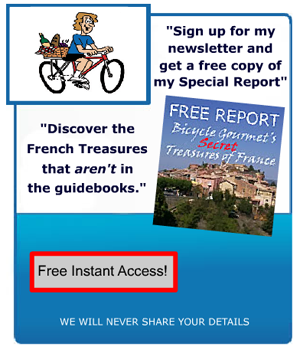French Faux Champagne Fight.

The French Faux Champagne Fight is a serious battle. Ongoing. And, and the best Hollywood tradition – it’s a David and Goliath mix-up. But, more on that later.
First – important to clarify what I mean by “faux” French Champagne. Not, as you might imagine Champagne produced by non-Frenchies claiming to be the real thing. And not “others” (read – “Americans”) labelling any bubbly as “Champagne.”
True, real champagne, comes only from the Champagne region of France. The froggie winos have agreed that anything bubbly outside it’s borders is to be labelled “Cremant.” One of ther oldest of such effervescent beverages hails from the Limoux region. And it has a history that goes back to a monk for whom a famous bubbly is named: Dom Perignon.
Reuters Marcel Michaelson has the sparkling details:
“Limoux barely escaped historical relegation as a local speciality by a flood of Spanish fizz from the other side of the Pyrénées mountains and is now fighting its corner with an offer of quality sparkling wines at affordable prices for its sweet traditional Blanquette de Limoux Methode Ancestrale and dryer Blanquette de Limoux Brut.
“Twenty years ago the quality of Limoux wines in general was not very good,” said Richard Planas, the director of the AOC Limoux professional body. “A lot of work has been done and a lot has changed.”
Limoux lies to the south of the Medieval walled city of Carcassonne, not far from the Mediterranean and the eastern Pyrénées. The area has plenty of sun and rain while the winds from both the Mediterranean and the Atlantic Ocean soften the temperature extremes in both summer and winter.
The Roman historian Livy who died in 17 AD mentioned wines from Limoux, but the first mention of a sparkling wine from the area was found in 1531 records kept by the Benedictine monks of the abbey of Saint Hilaire, near the town.
“It is of course difficult to claim being the first, sparkling wine is a natural effect of yeast and it could have been discovered at several places around that time,” Planas said.
Other sparkling wines with a long pedigree are the Gaillac bubbly, also from the southwest, and the Clairette de Die from the northeast.
Legend has it that Dom Pérignon travelled during a pilgrimage to the Saint-Hilaire abbey – on the way to Santiago de Compostela in northern Spain and discovered the process of sparkling wines there.
On return to his abbey of Saint-Pierre d’Hautvillers near Reims, he started to experiment with the technique on local wines from the Champagne region with another monk, Dom Thiery Ruinart. Champagne quickly overshadowed its predecessors.
“Champagne is in another league altogether, both in volume terms as in price,” said Planas.
Blanquette means “white one” in southern French, a term also used for a cream sauce in such dishes as the ‘Blanquette de veau’ traditional veal stew.
In 1975, French vintner groups decided that bubbly wines from outside the Champagne are should be labelled “Crémant” (creamy) and the country now knows various varieties such as the Crémant de Bourgogne, Crémant de Loire, Crémant de Bordeaux, Crémant de Jura and also Crémant de Limoux. The term crémant may only be used on wine from France and Luxembourg.
These wines were widely consumed in France as a cheaper, and often regional, alternative to Champagne. But they themselves lost ground to Cava sparkling wine from Catalonia in Northern Spain, with Barcelona’s Freixenet as a big brand name, or the Asti Spumante or Prosecco from Italy.
ANT VS SHOVEL
“For us, the biggest competition is from the Cava,” said Planas. “It is a battle between an ant and a shovel; they make some 300 million bottles against our 10 million.”
Spanish Cava production makes it the second-biggest growing area of sparkling wine after Champagne. Since 1986 when Spain joined the European Economic Community, a forerunner of the EU, the cava found its way across the mountains and to other countries. Limoux only has limited means to resist.
There are 7,800 hectares of vines spread over 41 villages around Limoux, producing sparkling and ‘normal’ wines.
The Blanquette Brut predominantly uses a local grape variety, the Mauzac. Up to 10 percent of Chenin and Chardonnay are permitted.
The producers harvest and press grapes from various parcels and start making basis wines with the first fermentation. These are tasted to determine the blend for the final product.
The blend is put in bottles and a special mixture is added to provoke a second fermentation that creates the bubbles. This second fermentation takes nine months, during which the bottles are regularly turned to let the sediments settle in the neck.
The Crémant de Limoux is made with Chardonnay and Chenin and some addition of Mauzac and Pinot Noir. The Blanquette Methode Ancestrale uses only Mauzac, is trickier to make and needs to be bottled in March when the moon is at a certain point.
No mixtures are added to the bottles at the beginning of the second fermentation and some sediment remains in the bottle. These ‘pure’ traditional wines are sweeter due to the sugar in Mauzac that fuels the fermentation.”
Read more HERE.
THROW ME A BONE HERE, PEOPLE!
What are ya thinkin’?

viva dom perignon!
you always come up with some fascinating story around wine, etc.
way to go! much appreciated!!!
it seems that monks have always been very “spiritually” attached to alcohloic beverage making – lucky for us!
very informative post. love your style!
interesting to learn that spain is the biggest competition for the french with this.
always very much to be learning from your excellent reports. many thanks my friend.
here in holland we prefer the french wines..not just because they are close…..but for their quality. iin fact…there is little difference in price.
didn’ t know there was another (resl) version of “bubbly” until this post. bravo!
didn’ t know there was another (resl) version of “bubbly” until this post.
your info is good, as always…and what i really kile is the way you give us the story behind how it all developed…the monks and all that i mean.
your information on limoux is especially welcome….i visited last year and was very impressed with everything there..especially the wine!
if only we could virtually taste some of your posts. this one in particular!
i’m with you norman!
just a side note to this excellent post…and not even french either..”asti spumanti”…is now just “spumanti.”
more first rate reporting….you make me thirsty! (and that’s a good thing!)